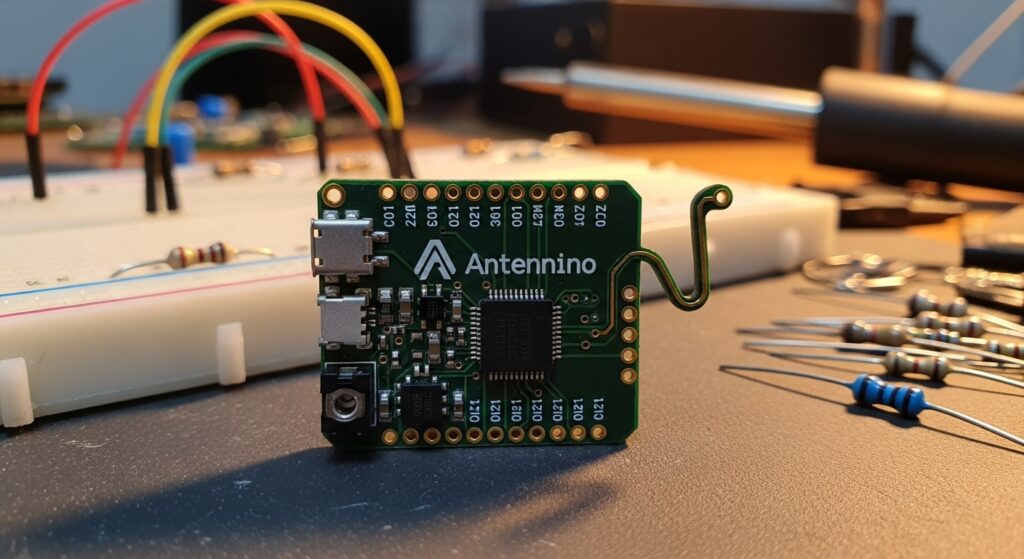The Antennino is a groundbreaking innovation in the world of microcontrollers, combining the flexibility of Arduino with compact design and wireless capabilities. As the world of electronics and IoT (Internet of Things) continues to expand, hobbyists, engineers, and makers are constantly searching for efficient and cost-effective solutions. Antennino stands out as a unique, open-source, and Arduino-compatible platform that simplifies the process of developing smart wireless devices.
Whether you are a beginner experimenting with sensors or an experienced developer building a wireless network of connected devices, Antennino offers the perfect balance of simplicity, power, and affordability. This article dives deep into what Antennino is, how it works, and why it has become an essential tool for modern electronics enthusiasts.
What is Antennino
Antennino is a compact, low-power, and radio-equipped development board based on the Arduino platform. Its key feature lies in its integrated RF (Radio Frequency) transceiver, allowing wireless communication between multiple boards without external modules.
Developed with the open-source community in mind, Antennino enables rapid prototyping of Internet of Things (IoT) devices, automation systems, and sensor networks. Because of its compatibility with Arduino IDE, users can write, upload, and run sketches seamlessly, just like with any other Arduino board.
| Feature | Description |
|---|---|
| Processor | ATmega328P (Arduino-compatible) |
| Wireless Module | nRF24L01+ integrated transceiver |
| Voltage Range | 1.8V – 3.6V |
| Programming | Arduino IDE compatible |
| Power Consumption | Ultra-low for battery-powered use |
| Connectivity | Wireless mesh networking |
| Open Source | Yes, fully documented and modifiable |
The integration of these components makes Antennino a versatile solution for wireless applications where size and energy efficiency are crucial.
Why Choose Antennino
When comparing Antennino with other development boards, its unique blend of size, functionality, and cost efficiency becomes evident. Below are some compelling reasons why Antennino is a top choice for makers:
-
Wireless Capability: Built-in radio modules remove the need for additional transceivers, reducing complexity.
-
Low Power Consumption: Perfect for long-term battery-powered projects.
-
Arduino Compatibility: Full integration with Arduino libraries and programming environment.
-
Expandable Design: Easy to connect sensors, actuators, and other peripherals.
-
Open-Source Platform: Encourages customization and community collaboration.
These features position Antennino as a go-to board for IoT developers seeking lightweight, energy-efficient wireless solutions.
Applications of Antennino
Because of its wireless capabilities and flexibility, Antennino has found applications in numerous fields, such as:
-
Home Automation: Smart lighting, security, and temperature monitoring systems.
-
Industrial IoT: Machine monitoring, data logging, and sensor-based alerts.
-
Agriculture: Soil moisture and environmental condition monitoring.
-
Environmental Sensing: Air quality and weather data collection.
-
Education: Teaching embedded systems and wireless communication concepts.
Below is a comparison table showing how Antennino stacks up against similar development boards in these fields:
| Application Area | Antennino Advantage | Alternative Boards |
|---|---|---|
| Home Automation | Built-in wireless networking | ESP8266 (external module required) |
| IoT Projects | Low power, easy to deploy | Raspberry Pi Pico (needs RF shield) |
| Environmental Sensing | Compact design, long battery life | Arduino Uno (bulkier, higher power) |
| Education | Simplified coding and setup | NodeMCU (requires Wi-Fi) |
Clearly, Antennino excels in wireless, low-power, and compact solutions, making it ideal for projects where efficiency and reliability are key.
How Antennino Works
At its core, Antennino uses an ATmega328P microcontroller—the same one found in many Arduino boards—paired with an nRF24L01+ wireless transceiver. This setup allows seamless data communication between multiple devices without external antennas or modules.
The workflow is simple:
-
Programming: Upload Arduino-compatible sketches using the Arduino IDE.
-
Power Supply: Operates efficiently with low voltage, making it suitable for batteries.
-
Communication: Uses the RF transceiver to send and receive data packets.
-
Networking: Multiple boards can communicate in a mesh network, allowing scalable IoT systems.
This combination makes Antennino extremely reliable for applications requiring long-range, low-latency wireless communication.
Setting Up Antennino
Getting started with Antennino requires minimal effort. Here’s a step-by-step guide to setting up the board:
-
Install Arduino IDE: Download and install the latest version.
-
Add Board Files: Integrate its core into the IDE using the official GitHub repository.
-
Connect the Board: Use an FTDI adapter to connect to your computer.
-
Upload Sketch: Write or upload your program and select the appropriate board settings.
-
Power and Deploy: Once uploaded, disconnect and power the board with batteries or external supply.
With these steps, your device will be ready to function in your IoT project within minutes.
Advantages of Antennino Over Other Boards
The Antennino offers numerous advantages compared to traditional Arduino boards or similar alternatives.
| Feature | Antennino | Standard Arduino |
|---|---|---|
| Wireless Built-in | Yes | No |
| Power Efficiency | High | Moderate |
| Compact Size | Very Small | Medium |
| Networking Capability | Mesh Network | Limited |
| Battery Life | Extended | Average |
The most significant advantage of is its built-in radio transceiver, which allows multiple devices to communicate wirelessly without external hardware. This reduces both cost and space while improving performance.
Future of Antennino in IoT and Embedded Systems
As the Internet of Things continues to expand globally, compact and efficient boards like Antennino are expected to play a crucial role. The open-source nature of the board means developers can continuously improve and adapt it for emerging technologies.
Possible future improvements include:
-
Integration with Bluetooth Low Energy (BLE) modules.
-
Enhanced power management for ultra-low consumption.
-
Expansion of libraries for sensor integration.
-
Cloud connectivity through gateways.
The growing popularity of among hobbyists and professionals highlights its potential to become a standard for wireless microcontroller-based systems.
Community and Support
A strong community backs the Antennino ecosystem, providing resources, tutorials, and example projects online. Makers share code snippets, troubleshooting tips, and hardware modifications that help new users get started quickly.
Additionally, the open-source repository includes detailed schematics, firmware, and documentation, allowing anyone to contribute or customize their project.
For developers seeking to experiment with new technologies, offers a perfect blend of collaboration, innovation, and learning.
Conclusion
In summary, Antennino stands as a remarkable example of modern microcontroller design that bridges simplicity, power, and wireless connectivity. Its Arduino compatibility, open-source framework, and energy-efficient operation make it a vital tool for anyone exploring IoT or embedded systems.
Whether you’re building a smart home device, developing a sensor network, or experimenting with wireless communication, delivers everything you need in a single, compact package. As the future of IoT continues to unfold, tools like will undoubtedly lead the charge in accessible, innovative, and sustainable technology development.






